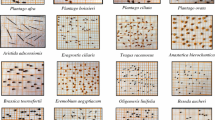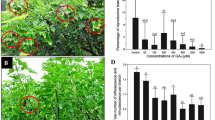Abstract
Amur adonis (Adonis amurensis) was used for the study of PGRs responses on the dormancy breaking and flowering. All plant treated with GA3 or GA4+7 showed earlier sprouting by breaking the dormancy and resulted to fast flowering, irrespective of concentration. Plant height and the number of nodes tent to be increased by GAs application on dormant plant. Among the different kinds of GA treatments, GA4+7 was most effective in dormancy breaking and flower emergence with the effect of higher plant height and increased node number rather than GA3. However, GA4+7 showed several disadvantages such as reducing the flowering rate and induced the overgrowth that resulting in stretched weak plants. Beside GA, cytokinins such as TDZ showed clear effect of dormancy breaking but, other cytokinins such as BAP and Kinetin showed no clear positive effects in breaking the dormancy. Dormant amur adonis treated with BAP and Kinetin flowered without leaf emergency and subsequent shoot growth resulted in showing abnormal flowering and growth, but it treated with TDZ showed the normal flowering with shoot growth, but flowering percentage was very low. In conclusion, we could recommend that 100–500 mg·L−1 GA3 application as an alternative method to chilling treatment for breaking dormancy and normal flowering of A. amurensis. And we could also recommend 20 or 50 mg·L−1 TDZ for the dormancy break and subsequent shoot growth, but not for flowering.
Similar content being viewed by others
Literature Cited
Ahn, Y.H. and T.J. Lee. 1997. The encyclopedia of native plant, p. 73–75. Tree for life Publishing Co., Seoul, Korea.
Broome, O.C. and R.H. Zimmerman. 1976. Breaking bud dormancy in tea crabapple Malus hupehensis (Pamp.) Rehd. with cytokinins. J. Amer. Soc. Hort. Sci. 101:28–30.
Cho, K.S., J.E. Jang, D.L. Yoo, S.Y. Ryu, and Y.R. Yong. 2001. Effects of low temperature and GA3 treatments on the growth and flowering of Hanabusaya asiatica. J. Kor. Soc. Hort. Sci. 42:116–120.
Fellman, C.D., P.E. Read, and M.A. Hosier. 1987. Effects of thidiazuron and CPPU on meristem formation and shoot proliferation. Hort-Science 22:1197–1200.
Ji, Z.L. and S.Y. Wang. 1984. Reduction of abscisic acid content and induction of sprouting in potato, Solanum tuberosum L., by thidiazuron. J. Plant Growth Regul. 7:37–44.
Jung, W.Y., J.A. Kim, I.S. Park, and K.W. Kim. 2000. Effect of tunic and plant growth regulators on dormancy breaking and growth of Gladiolus cormels. J. Kor. Soc. Hort. Sci. 41:535–539.
Lang, G.A. 1994. Dormancy — the missing links: molecular studies and integration of regulatory plant and environmental interactions. HortScience 29:1255–1263.
Lee, J.S. and J.Y. Kim, 1999. Effects of low temperature and GA3 treatment on the dormancy breaking of Cypripedium macranthum native to Korea. J. Kor. Soc. Hort. Sci. 40:389–391.
Lim, Y.H., M.H. Kim, M.S. Byun, and K.W. Kim. 2007. Effects of GA3 and chilling treatment on growth and flowering in perennial Korean native plants. Flower Res. J. 15:123–123.
Shirazi, A.M. 2003. Standardizing methods for evaluating the chilling requirements to break dormancy in seeds and buds (including geophytes): Introduction to the workshop. HortScience 38:334–335.
Shirazi, A.M. and L.H. Fuchigami. 1995. Effects of ‘near-lethal’ stress on bud dormancy and stem cold hardiness in red-osier dogwood. Tree Physiol. 15:275–279.
Steffens, G.L. and G.W. Stutte. 1989. Thidiazuron substitution for chilling requirement in three apple cultivars. J. Plant Growth Regul. 8:301–307.
Suda, Y. and Y. Adachi. 1991. Differentiation of Adonis L. in Japan. II. Distribution and flowering period. Sci. Rep. Tohoku Univ. 40:65–76.
Suttle, J.C. 1998. Postharvest changes in endogenous cytokinins and cytokinin efficacy in potato tubers in relation to bud endodormancy. Physiol. Plant. 103:59–69.
Thomas, J.C. and F.F. Katterman. 1986. Cytokinin activity induced by thidiazuron. Plant Physiol. 81:681–683.
Turnbull, C.G.N. and D.E. Hanke. 1985. The control of bud dormancy in potato tubers: Evidence for the primary role of cytokinins and a seasonal pattern of changing sensitivity to cytokinin. Planta 165: 359–365.
Walker, D.R. and C.W. Donoho. 1959. Further studies on the effect of gibberellic acid on breaking the rest period of young peach and apple trees. Proc. Amer. Soc. Hort. Sci. 74:87–92.
Wang, S.Y., G.L. Steffens, and M. Faust. 1986. Breaking bud dormancy in apple with a plant bioregulator, thidiazuron. Phytochemistry 25:311–317.
Wang, S.Y., Z.L. Ji, T. Sun, and M. Faust. 1987. Effects of thidiazuron on abscisic acid content in apple bud relative to dormancy. Physiol. Plant. 71:105–109.
Wareing, P.F. and P.F. Saunders. 1971. Hormones and dormancy. Ann. Rev. Plant Physiol. 22:261–288.
Wisniewski, M., L.H. Fuchigami, J.J. Sauter, A. Shirazi, and L. Zhen. 1996. Near-lethal stress and bud dormancy in woody plants. p. 201–210. In: G.A. Lang (ed.) Plant dormancy physiology, biochemistry and molecular biology. CAB International, Wallingford, U.K.
Yip, W.K. and S.F. Yang. 1986. Effect of thidiazuron, a cytokine-active urea derivative, in cytokinin-dependent ethylene production system. Plant Physiol. 80:515–519.
Yoo, S.O. and J.H. Bae. 1999. Breaking dormancy for early production of young leaves in butterbur rootstock (Petasites japonicus Max.). J. Kor. Soc. Hort. Sci. 40:545–548.
Author information
Authors and Affiliations
Corresponding author
Rights and permissions
About this article
Cite this article
Jung, H.H., Kim, K.S. Flowering of Adonis amurensis by breaking dormancy using gibberellins and cytokinins. Hortic. Environ. Biotechnol. 52, 246–251 (2011). https://doi.org/10.1007/s13580-011-2011-6
Received:
Accepted:
Published:
Issue Date:
DOI: https://doi.org/10.1007/s13580-011-2011-6




